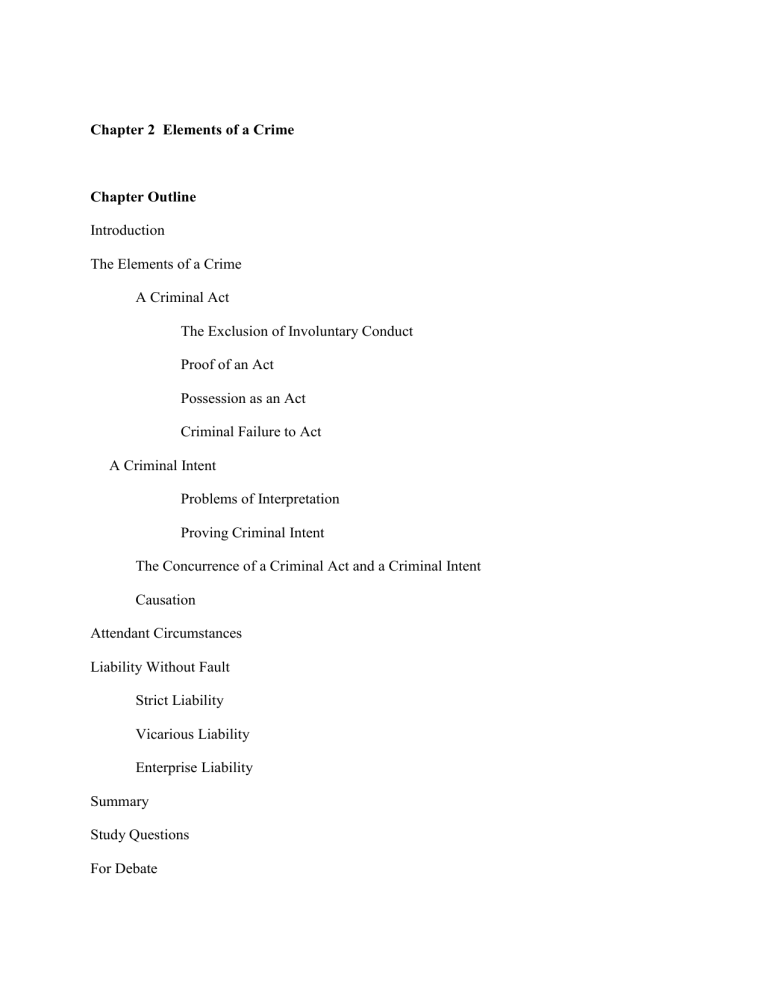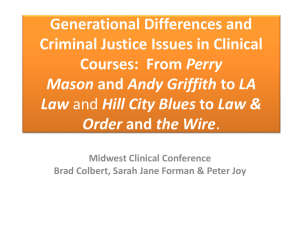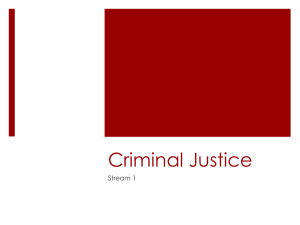Chapter 2 Elements of a Crime
advertisement

Chapter 2 Elements of a Crime Chapter Outline Introduction The Elements of a Crime A Criminal Act The Exclusion of Involuntary Conduct Proof of an Act Possession as an Act Criminal Failure to Act A Criminal Intent Problems of Interpretation Proving Criminal Intent The Concurrence of a Criminal Act and a Criminal Intent Causation Attendant Circumstances Liability Without Fault Strict Liability Vicarious Liability Enterprise Liability Summary Study Questions For Debate Key Terms Case Analysis Internet Activity Notes Key Terms Actus reus: A wrongful deed that, if combined with the other elements of a crime, may result in the legal arrest, trial, and conviction of the accused. Attendant circumstances: Additional element (or elements) that must accompany the criminal act and the criminal mind; essentially they are facts surrounding an event. Causation: A relationship between two phenomena in which the occurrence of the former brings about changes in the latter. In the legal sense, causation is the element of a crime that requires the existence of a causal relationship between the offender’s conduct and the particular harmful consequences. Circumstantial evidence: Evidence of facts other than those on which proof is needed but from which deductions or inferences may be drawn concerning the facts in dispute. Corpus delicti: The body or other material substance of a crime that constitutes the foundation of that particular crime. Corroborating evidence: Additional data to support the crime charged, especially in rape and other cases in which there were no witnesses to the alleged act and the evidence is crucial to proving a case. Culpability: Being guilty or at fault through action or inaction. Four criteria may be used to determine culpability: intention, knowledge, negligence, and recklessness. Different crimes may require different kinds of culpability to prove guilt. Elements of a crime: In general, for an act to be a crime in the U.S. criminal justice system, four elements must be present: a criminal act, a criminal state of mind, concurrence of a criminal act and a criminal state of mind, and causation. Enterprise liability: The process of holding corporations or business enterprises criminally culpable for the criminal acts (or omissions) of agents who are acting on behalf of the enterprise. Inference: A concept permitting the drawing of a conclusion based on other facts or logic presented in a case. The jury may use its reason and common sense to infer, for example, that based on certain evidence a crime was committed by the defendant. Intent: The state of mind referring to the willful commission of an act or the omission of an act. See also Mens rea. Intervening act: An act that occurs after an alleged criminal act and the resulting injury; may be considered the legal cause, or at least a contributing cause, of the harm. Legal duty: Duty imposed by statutory or case law or through an explicit or implied contract, such as the duty imposed on parents to come to the aid of their children, on physicians to aid their patients, or any duty imposed by such contracts as marriage, employment, or custody. Mens rea: Criminal intent, the guilty or evil mind required for criminal liability. Motive: The why or reason for a defendant’s actions. Negligence: An act that a reasonable person would not do or the failure to do something that a reasonable person would do under the same or similar circumstances. Statutory rape: Sexual intercourse or, in some jurisdictions, other sexual acts with an underage person even though that person allegedly consented. An underage person is deemed by the law to be incapable of giving legal consent to sexual acts. Strict liability: Liability without fault; criminal culpability is imposed in some situations even though no fault or evil intent can be shown on the part of the accused essentially it is not necessary to prove criminal intent. Substantial factor: Factor that a reasonable person might conclude was sufficient to support the resulting injury or death. Vicarious liability: The placing of legal liability on one person or corporation for the action of another. An example would be to hold the owner of a bar responsible for an employee who sold liquor to an intoxicated person who then drove a car and killed another person. Year-and-a-day rule: Common law rule requiring that for a murder charge, death of the victim must occur within one year and one day from the time the alleged crime was committed. With advances in medical science, many jurisdictions have extended or abolished this rule. Chapter Overview For a crime to be committed under U.S. law, four things must be present at the same time: an act, a state of mind, the concurrence of the two, and causation. Additional or attendant circumstances may also be necessary to make a particular crime into another crime. The criminal act, or actus reus, is open to interpretation and requires significant discussion on its own. The requirement of a criminal act generally prohibits the state from punishing someone for holding a certain status or condition. Involuntary acts are not generally considered criminal, although there are some exceptions to this rule. The concept of culpability is crucial to the understanding of criminal law. Determining the difference between a voluntary act and an involuntary act is not always easy, and it may be difficult to prove that an act occurred at all. It is critical to understand that every criminal law includes elements, and each must be proved beyond a reasonable doubt to establish guilt. Merely possessing something can be an act. Failure to act may also be a crime in some instances. Criminal intent and a level of culpability are essential, and it is important to distinguish between general intent and specific intent. Proving criminal intent involves the role of motive, inferences, and circumstantial evidence. Proving causation is essential in most criminal statutes. The role of attendant circumstances is important for interpreting the nature of an act. Strict liability statutes impose criminal liability, even given other circumstances. Often it is possible to impose vicarious criminal liability on one person for the actions of another in the defendant’s employ. Learning Objectives After studying this chapter the student will: 1. Know that the four elements of all criminal acts must be present at the same time: act, state of mind, concurrence, and causation. 2. Know what attendant circumstances means and recognize when they are included in a particular statute. 3. Be able to define and discuss actus reus. 4. Be able to discuss why the criminal law is prohibited from punishing on the basis of status or condition. 5. Be able to explain why involuntary acts are usually not considered criminal and to name the exceptions to that rule. 6. Be able to explain the burden of proof in criminal cases. 7. Know that all criminal offenses have specific elements required to be proven by the government. 8. Be able to describe when possession may be considered the actus reus. 9. Know that in some instances failure to act may lead to criminal culpability. 10. Know the meaning of specific intent and general intent and give an example of each. 11. Know that proving intent requires the use of inferences and circumstantial evidence. 12. Be able to define strict liability and vicarious liability and be able to give an example of each. Review Questions 1. What are the four elements required of all criminal acts? 2. Discuss the importance of concurrence in a criminal offense. 3. What are “attendant circumstances,” and how do they affect the evidence in a criminal case? 4. Explain actus reus and its importance in charging a criminal offense. 5. Why is the criminal law prohibited from punishing on the basis of status and condition? 6. Why are involuntary acts usually not considered criminal, and what are the exceptions to that rule? 7. What is the burden of proof in criminal cases? 8. What exactly is it that the government in a criminal case bears the burden of proof upon? 9. Discuss when and how possession may be considered the actus reus of a crime. 10. Explain specific and general intent, and give an example of each. 11. Explain why we use inferences and circumstantial evidence to prove intent. 12. What do we mean by the term strict liability? Give an example of this kind of offense. 13. What do we mean by the term vicarious liability? Give an example of this kind of offense. Multiple Choice Questions 1. The term mens rea is defined as: a. a criminal act. b. knowing. c. a guilty mind. d. mental culpability. 2. The term actus reus is defined as: a. a criminal act. b. knowing. c. a guilty mind. d. mental culpability. 3. The process of holding corporations or business enterprises criminally culpable for the criminal acts (or omissions) of their agents who are acting on behalf of the enterprise is: a. enterprise liability b. vicarious liability c. negligence. d. strict liability. 4. Statutory rape and selling alcohol to a minor are both considered what type of liability? a. vicarious liability b. strict liability c. enterprise liability d. negligence 5. Generally, when a criminal statute defines possession as a crime, the word is interpreted to mean ______________ possession. a. constructive b. actual c. physical d. conscious 6. Which U.S. Supreme Court case invalidated a state statute that made it a misdemeanor for a person to “be addicted to the use of narcotics”? a. Furman v. Georgia b. Robinson v. California c. People v. Decina d. People v. Stewart 7. _________________ is utilized as a level of culpability in the Model Penal Code’s provision concerning the general requirements of culpability. a. Knowingly b. Voluntarily c. Capably d. Involuntarily 8. Deductions or inferences drawn concerning the facts in dispute is called ____________________ evidence. a. circumstantial b. critical c. credible d. character 9. The remains of a burned building may be evidence of: a. intent. b. causation. c. concurrence. d. corpus delecti. 10. Reflexes or convulsions, movements made during sleep or unconsciousness, and conduct engaged in while a person is under hypnosis are all examples of ________________ acts. a. voluntary b. intentional c. involuntary d. unintentional 11. The why of a defendant’s actions is called the: a. actus reus. b. causation. c. motive. d. mens rea. 12. A(n) __________________ is something that a reasonable person might conclude was sufficient to support the resulting injury or death. a. intention b. substantial factor c. culpability d. mitigating circumstance 13. A(n) ______________ act that occurs after an alleged criminal act and the resulting injury may be considered the legal cause, or at least a contributing cause, of the harm. a. intervening b. circumstantial c. prior d. intentional 14. Additional element (or elements) that must accompany the criminal act and the criminal mind (essentially facts surrounding an event) are: a. mitigating. b. consequential. c. related. d. attendant. 15. Sexual intercourse or, in some jurisdictions, other sexual acts with an underage person even though that person allegedly consented is: a. rape. b. forcible sodomy. c. statutory rape. d. molestation. 16. What type of liability dispenses with the requirement of the actus reus and imputes the criminal act of one person to another? a. strict b. vicarious c. enterprise d. Circumstantial 17. Corporations are held responsible for the criminal acts of their agents only when those agents are acting: a. within the scope of the corporate employment. b. on their own. c. with two or more persons. d. with malice aforethought. 18. Which of the following is an element that must be present in order for an act to be considered a crime? a. causation b. attendant circumstances c. inference d. negligence 19. Which court case established that the law permits an inference of intent from relevant facts? a. Rocky v. State b. State v. Rockstar c. Rockstar v. State d. State v. Rocker 20. A factor that a reasonable person might conclude was sufficient to support resulting injury or death is known as a: a. risk factor. b. substantial factor. c. criminal factor. d. attendant factors. Fill-in-the-Blank Questions 1. ____________________ Liability without fault; criminal culpability is imposed in some situations even though no fault or evil intent can be shown on the part of the accused; essentially it is not necessary to prove a criminal intent. 2. ____________________ Factor that a reasonable person might conclude was sufficient to support the resulting damage to property or personal injury or death. 3. ____________________ The body or other material substance of a crime that constitutes the foundation of that particular crime. 4. ____________________ Being guilty or at fault through action or inaction. Four criteria may be used to determine culpability: intention, knowledge, negligence, and recklessness. 5. ____________________ Additional data to support the crime charged, especially in rape and other cases in which there were no witnesses to the alleged act and the evidence is crucial to proving a case. 6. ____________________ A relationship between two phenomena in which the occurrence of the former brings about changes in the latter. 7. ____________________ The process of holding corporations or business enterprises criminally culpable for the criminal acts (or omissions) of their agents who are acting on behalf of the enterprise. 8. ____________________ An act that occurs after an alleged criminal act and the resulting injury; may be considered the legal cause, or at least a contributing cause, of the harm. 9. ___________________ A state of mind referring to the willful commission or omission of a criminal act. 10. ___________________ Additional element (or elements) that must accompany the criminal act and the criminal mind—essentially facts surrounding an event. 11. ___________________ Evidence of facts other than those of which proof is needed but from which deductions or inferences may be drawn concerning the facts in dispute. 12. ___________________ Criminal intent—the guilty or evil mind required for criminal liability. 13. ___________________ An act that a reasonable person would not do or the failure to do something that a reasonable person would do under the same or similar circumstances. 14. ___________________ Sexual intercourse or, in some jurisdictions, other sexual acts as well with an underage person even though that person consented. 15. ___________________ A wrongful deed that, if combined with the other elements of a crime, may result in the legal arrest, trial, and conviction of the accused. 16. ___________________ Duty imposed by statutory or case law or through an explicit or implied contract, such as the duty imposed on parents to come to the aid of their children, on physicians to aid their patients, or any duty imposed by such contracts as marriage, employment, or custody. 17. ___________________ The placing of legal liability on one person or corporation for the action of another. 18. ___________________ The why or reason for a defendant’s actions. 19. ___________________ This must be distinguished from motive. 20. ___________________ Rule intended to prevent murder charges from being brought long after the criminal attack. 21. ___________________ Under liability without fault, it is essential for compensation of victims as well as for deterrence of others. 22. ___________________ This type of crime was intended for the protection of girls considered to be too young to consent to sex. 23. ___________________ Court case in which the U.S. Supreme Court held that “The act of agent, while exercising the authority delegated to him . . . may be controlled, in the interest of public policy, by imputing his act to his employer and imposing penalties upon the corporation for which he is acting.” 24. ___________________ In this court case, the Fifth District Court of Appeals emphasized the economic benefits that corporations might enjoy if they were not responsible for damages and personal injuries (or deaths) caused by their defective products. 25. ___________________ The type of liability where the actus reus of one actor is imputed to another person. Short Answer Questions 1. List the elements that must be present to constitute a crime in the U.S. criminal justice system. 2. Define negligence. 3. Discuss what is meant by an involuntary act. 4. What are the three types of liability without fault and how are they different? 5. Explain general and specific intent ANSWER KEY Multiple Choice Questions 1. c 2. a 3. a 4. b 5. d 6. b 7. a 8. a 9. d 10. c 11. c 12. b 13. a 14. d 15. c 16. b 17. a 18. a 19. d 20. b Fill-in-the-Blank Questions 1. strict liability 2. substantial factor 3. corpus delecti 4. culpability 5. corroborating evidence 6. causation 7. enterprise liability 8. intervening act 9. intent 10. attendant circumstances 11. circumstantial evidence 12. mens rea 13. negligence 14. statutory rape 15. actus reus 16. legal duty 17. vicarious liability 18. motive 19. intent 20. year-and-a-day 21. criminal culpability 22. statutory rape 23. New York Central and Hudson River Railroad Co. v. United States 24. Granite Construction Co. v. Superior Court 25. vicarious liability









